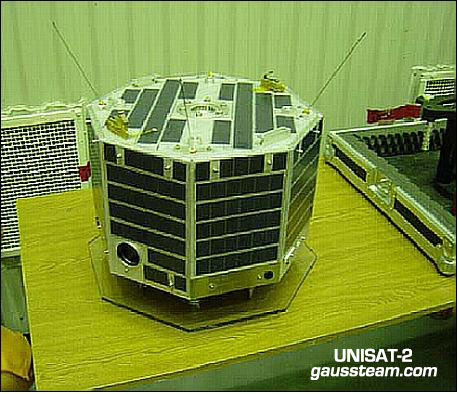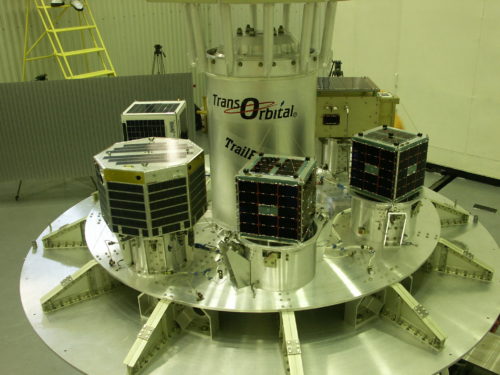UniSat-2 is the second experimental microsatellite developed in the framework of the University Satellites Program (UNISAT), carried out from GAUSS Group of Rome at Scuola di Ingegneria Aerospaziale (of Università di Roma “La Sapienza”) where students and researchers had the opportunity to enhance their education and benefit of hands-on experiences in the field of aerospace engineering, manufacturing and integrating didactical and low-cost microsatellites. The spacecraft was built in GAUSS Laboratory of the School, with grants from the Ministry of Research and the Italian Space Agency (ASI).

Characteristics
- UniSat-2 is an octagonal prism with a modular structure consisting of honeycomb plates, kept together by four aluminum bars, of size similar to UniSat-2, 15 cm lenght x 25 cm height, but with a heavier mass weighting about 17 kg
- Spin stabilized, it has magnetorquers for attitude manoeuvres
- Communication system: UHF and VHF radio equipment link communicate with the ground station at radio amateurs frequency of 435 Megahertz
- Power: solar cells and commercial Li-Ion batteries
- Onboard data handling system
- Off the Shelf subsystems components
- Contains scientific payloads
Mission Objectives and Payloads
- Earth Observation, through a sensor for space debris impact/effect detection and monitoring
- Commercial camera to transmit Earth imagery
- Spectrometer‘s monitoring aerosols and water vapor
- Technology demonstration: experiments testing terrestrial devices for Space applications, operating them in-orbit, e.g. innovative smaller Lithium-Ion batteries
- Testing a couple of Microthrusters for attitude control to validate and demonstrate an onboard micropropulsion system, followed by a performance assessment. The spin stabilized micropopulsion experiment (microthruster) was developed in cooperation with Mechatronic (from Wien) and Istituto Nazionale di Fisica della Materia of Trieste. Tests are precursory to more complex future missions, demonstrating the possibility to use components off the shelf to reduce the costs and do research experiments
- Small Sun sensor
- Space science: Education scientific research.

UniSat-2 and the other microsatellites during the integration phase on the launcher, in Baikonur, prior the Cluster Launch on DNEPR in December 2002
The Launch
UniSat-2 has been successfully launched in LEO orbit (Near-circular Orbit height 650km, 65 degrees circa) from the DNEPR LV (managed by Kosmotras ISC) during the Cluster Launch on 20 December 2002, after the tests implemented at Baikonur Cosmodrome, the launch site in Kazakhstan.
The multiple launch comprised other 5 microsatellites: Rubin-2 from Germany, SaudiSat-1C from Saudi Arabia, LatinSat-A and LatinSat-B from USA, 2001 TrailBlazer from USA.
